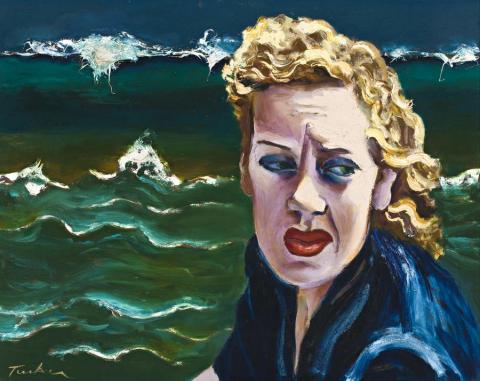JOY HESTER, 1983
ALBERT TUCKER
oil on composition board
60.5 x 76.0 cm
signed lower left: Tucker
Tolarno Galleries, Melbourne (label attached verso)
Private collection, Melbourne
Albert Tucker: A Retrospective, National Gallery of Victoria, Melbourne, 1990
Tucker, A., Faces I Have Met, Albert Tucker, Hutchinson of Australia, Melbourne, 1986, p. 35 (illus.)
Mollison, J. and Minchin, J., Albert Tucker: A Retrospective, National Gallery of Victoria, Melbourne, 1990, p. 72 (illus.)
Fry, G., Albert Tucker, Beagle Press, Sydney, 2005, p. 207 (illus.)
Joy Hester, 1946, oil on composition board, 46.0 x 33.6 cm, National Gallery of Australia, Canberra
Albert Tucker was an extraordinarily talented portraitist. This is seen as much in his revealing self-portraits as in the many of his friends and fellow artists. As a role call of the best would be too long, a few must suffice - Self, 1983 in the collection of the National Gallery of Victoria, Melbourne; Sidney Nolan, 1977 in a private collection; and Bernard Smith, 1985 in the National Portrait Gallery, Canberra. In strength, directness and penetrating honesty, these and others rank among the finest portraits painted in Australia. In each Tucker displayed his ability to reveal the inner character beneath the brow besieged by time - arrogant, haunted, and intellectually astute. His portraits of Joy Hester are dramatically poignant. In 1941, Tucker married the youthful Hester, who soon became part of the Heide circle of John and Sunday Reed, Arthur Boyd, Nolan and others. A vivacious blonde, strikingly attractive and of great artistic talent, Tucker recorded her beauty in numerous photographs and paintings. Something of her vitality and beauty is captured in his broad stroked wide-eyed 1946 portrait of Hester in the National Gallery of Australia. Very different in temperament, their relationship became turbulent. They separated in 1947.
During the late 70s and early 80s Tucker painted a number of portraits largely drawn from his photographs. They were exhibited at the Tolarno Galleries under the title of Faces I Have Met. Our portrait of Hester, together with the Nolan and Smith portraits mentioned above, were among the many works in the exhibition. Several of Hester, who died many years before, were painted from photographs of her in the 1940s. In a perceptive 1985 essay, Richard Haese drew attention to the surrealist and expressive manner in the broad handling of our portrait. He continued:
The tragic dimension of Joy Hester's life, especially the long and terrible fight against cancer from which she died in 1960, is present in the anguished turn of the head and the dark wall of breaking waves behind her. The sea refers not only to the beachside world of her youth but also, as Tucker has revealed, to a passage 'the long joyful sea hateth me' from Sidney Nolan's collection of poems on the period entitled Paradise Garden. As Tucker states: 'I almost wrote that on the bottom of the portrait ... power and menace. Something coming to overwhelm her, as it did.'1
Naturalism yielded to Expressionism. The detailed agitation of the face and blonde hair, and the deep blue of her dress are echoed in the white capped waves. Lips are remembered red and luscious, but eyes are shrouded in blues. In this powerfully charged image of recollection, realism gives way to an emotion still raw after all those years.
1. Haese, R., essay in Tucker, Faces I Have Met, op.cit., p. 6
DAVID THOMAS
